Parameswaran Raman
HLAT: High-quality Large Language Model Pre-trained on AWS Trainium
Apr 16, 2024
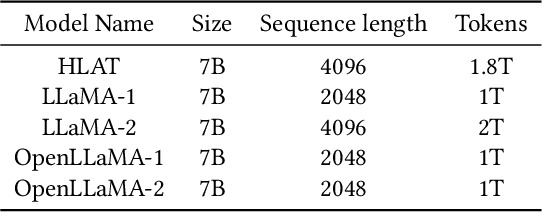
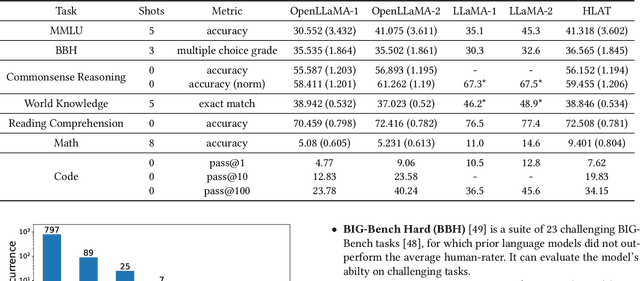

Abstract:Getting large language models (LLMs) to perform well on the downstream tasks requires pre-training over trillions of tokens. This typically demands a large number of powerful computational devices in addition to a stable distributed training framework to accelerate the training. The growing number of applications leveraging AI/ML had led to a scarcity of the expensive conventional accelerators (such as GPUs), which begs the need for the alternative specialized-accelerators that are scalable and cost-efficient. AWS Trainium is the second-generation machine learning accelerator that has been purposely built for training large deep learning models. Its corresponding instance, Amazon EC2 trn1, is an alternative to GPU instances for LLM training. However, training LLMs with billions of parameters on trn1 is challenging due to its relatively nascent software ecosystem. In this paper, we showcase HLAT: a 7 billion parameter decoder-only LLM pre-trained using trn1 instances over 1.8 trillion tokens. The performance of HLAT is benchmarked against popular open source baseline models including LLaMA and OpenLLaMA, which have been trained on NVIDIA GPUs and Google TPUs, respectively. On various evaluation tasks, we show that HLAT achieves model quality on par with the baselines. We also share the best practice of using the Neuron Distributed Training Library (NDTL), a customized distributed training library for AWS Trainium to achieve efficient training. Our work demonstrates that AWS Trainium powered by the NDTL is able to successfully pre-train state-of-the-art LLM models with high performance and cost-effectiveness.
EMC$^2$: Efficient MCMC Negative Sampling for Contrastive Learning with Global Convergence
Apr 16, 2024



Abstract:A key challenge in contrastive learning is to generate negative samples from a large sample set to contrast with positive samples, for learning better encoding of the data. These negative samples often follow a softmax distribution which are dynamically updated during the training process. However, sampling from this distribution is non-trivial due to the high computational costs in computing the partition function. In this paper, we propose an Efficient Markov Chain Monte Carlo negative sampling method for Contrastive learning (EMC$^2$). We follow the global contrastive learning loss as introduced in SogCLR, and propose EMC$^2$ which utilizes an adaptive Metropolis-Hastings subroutine to generate hardness-aware negative samples in an online fashion during the optimization. We prove that EMC$^2$ finds an $\mathcal{O}(1/\sqrt{T})$-stationary point of the global contrastive loss in $T$ iterations. Compared to prior works, EMC$^2$ is the first algorithm that exhibits global convergence (to stationarity) regardless of the choice of batch size while exhibiting low computation and memory cost. Numerical experiments validate that EMC$^2$ is effective with small batch training and achieves comparable or better performance than baseline algorithms. We report the results for pre-training image encoders on STL-10 and Imagenet-100.
Variance-reduced Zeroth-Order Methods for Fine-Tuning Language Models
Apr 11, 2024



Abstract:Fine-tuning language models (LMs) has demonstrated success in a wide array of downstream tasks. However, as LMs are scaled up, the memory requirements for backpropagation become prohibitively high. Zeroth-order (ZO) optimization methods can leverage memory-efficient forward passes to estimate gradients. More recently, MeZO, an adaptation of ZO-SGD, has been shown to consistently outperform zero-shot and in-context learning when combined with suitable task prompts. In this work, we couple ZO methods with variance reduction techniques to enhance stability and convergence for inference-based LM fine-tuning. We introduce Memory-Efficient Zeroth-Order Stochastic Variance-Reduced Gradient (MeZO-SVRG) and demonstrate its efficacy across multiple LM fine-tuning tasks, eliminating the reliance on task-specific prompts. Evaluated across a range of both masked and autoregressive LMs on benchmark GLUE tasks, MeZO-SVRG outperforms MeZO with up to 20% increase in test accuracies in both full- and partial-parameter fine-tuning settings. MeZO-SVRG benefits from reduced computation time as it often surpasses MeZO's peak test accuracy with a $2\times$ reduction in GPU-hours. MeZO-SVRG significantly reduces the required memory footprint compared to first-order SGD, i.e. by $2\times$ for autoregressive models. Our experiments highlight that MeZO-SVRG's memory savings progressively improve compared to SGD with larger batch sizes.
MADA: Meta-Adaptive Optimizers through hyper-gradient Descent
Jan 17, 2024



Abstract:Since Adam was introduced, several novel adaptive optimizers for deep learning have been proposed. These optimizers typically excel in some tasks but may not outperform Adam uniformly across all tasks. In this work, we introduce Meta-Adaptive Optimizers (MADA), a unified optimizer framework that can generalize several known optimizers and dynamically learn the most suitable one during training. The key idea in MADA is to parameterize the space of optimizers and search through it using hyper-gradient descent. Numerical results suggest that MADA is robust against sub-optimally tuned hyper-parameters, and outperforms Adam, Lion, and Adan with their default hyper-parameters, often even with optimized hyper-parameters. We also propose AVGrad, a variant of AMSGrad where the maximum operator is replaced with averaging, and observe that it performs better within MADA. Finally, we provide a convergence analysis to show that interpolation of optimizers (specifically, AVGrad and Adam) can improve their error bounds (up to constants), hinting at an advantage for meta-optimizers.
Krylov Cubic Regularized Newton: A Subspace Second-Order Method with Dimension-Free Convergence Rate
Jan 05, 2024


Abstract:Second-order optimization methods, such as cubic regularized Newton methods, are known for their rapid convergence rates; nevertheless, they become impractical in high-dimensional problems due to their substantial memory requirements and computational costs. One promising approach is to execute second-order updates within a lower-dimensional subspace, giving rise to subspace second-order methods. However, the majority of existing subspace second-order methods randomly select subspaces, consequently resulting in slower convergence rates depending on the problem's dimension $d$. In this paper, we introduce a novel subspace cubic regularized Newton method that achieves a dimension-independent global convergence rate of ${O}\left(\frac{1}{mk}+\frac{1}{k^2}\right)$ for solving convex optimization problems. Here, $m$ represents the subspace dimension, which can be significantly smaller than $d$. Instead of adopting a random subspace, our primary innovation involves performing the cubic regularized Newton update within the Krylov subspace associated with the Hessian and the gradient of the objective function. This result marks the first instance of a dimension-independent convergence rate for a subspace second-order method. Furthermore, when specific spectral conditions of the Hessian are met, our method recovers the convergence rate of a full-dimensional cubic regularized Newton method. Numerical experiments show our method converges faster than existing random subspace methods, especially for high-dimensional problems.
Contractive error feedback for gradient compression
Dec 13, 2023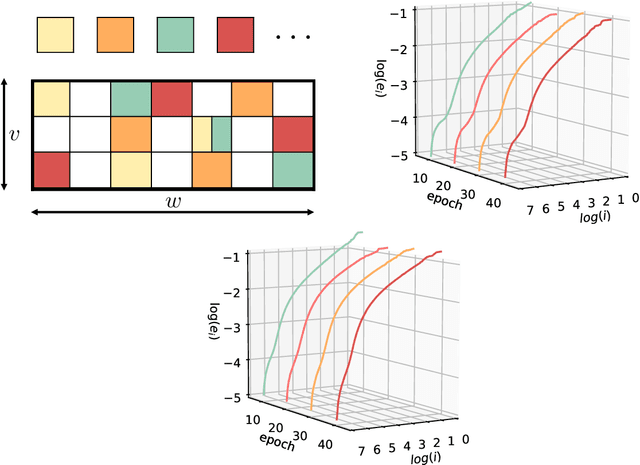

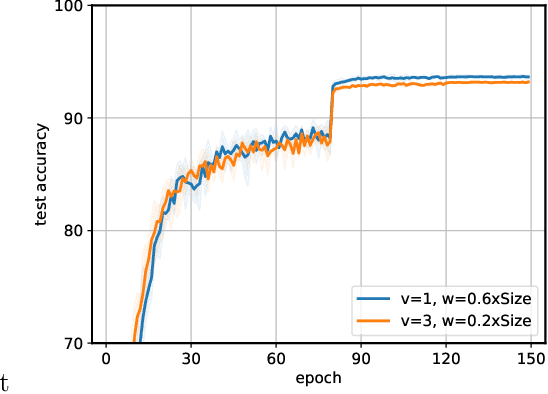
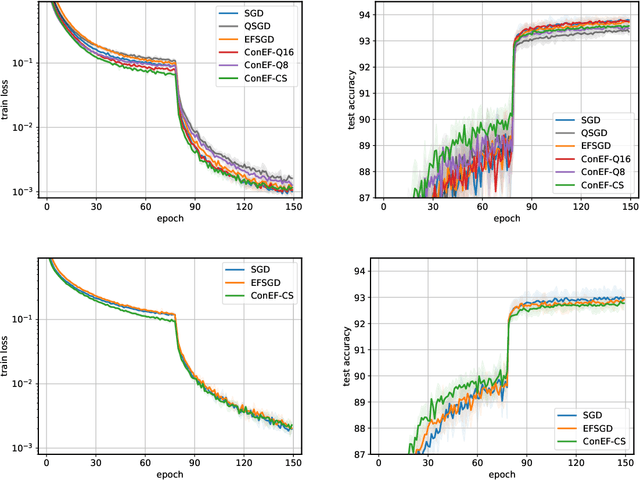
Abstract:On-device memory concerns in distributed deep learning have become severe due to (i) the growth of model size in multi-GPU training, and (ii) the wide adoption of deep neural networks for federated learning on IoT devices which have limited storage. In such settings, communication efficient optimization methods are attractive alternatives, however they still struggle with memory issues. To tackle these challenges, we propose an communication efficient method called contractive error feedback (ConEF). As opposed to SGD with error-feedback (EFSGD) that inefficiently manages memory, ConEF obtains the sweet spot of convergence and memory usage, and achieves communication efficiency by leveraging biased and all-reducable gradient compression. We empirically validate ConEF on various learning tasks that include image classification, language modeling, and machine translation and observe that ConEF saves 80\% - 90\% of the extra memory in EFSGD with almost no loss on test performance, while also achieving 1.3x - 5x speedup of SGD. Through our work, we also demonstrate the feasibility and convergence of ConEF to clear up the theoretical barrier of integrating ConEF to popular memory efficient frameworks such as ZeRO-3.
DS-FACTO: Doubly Separable Factorization Machines
Apr 29, 2020
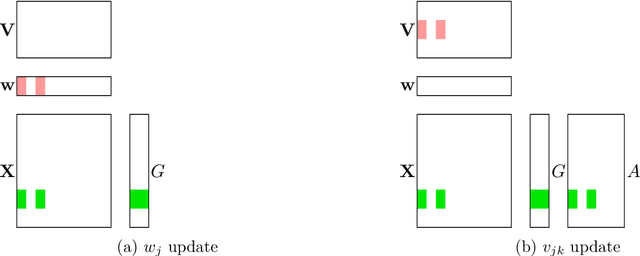
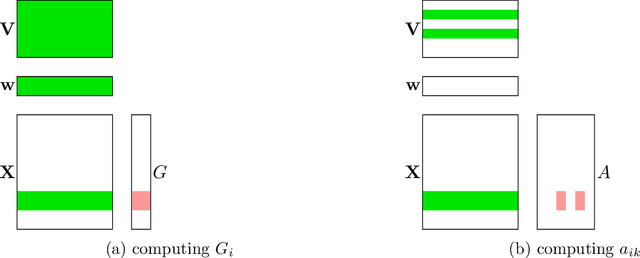
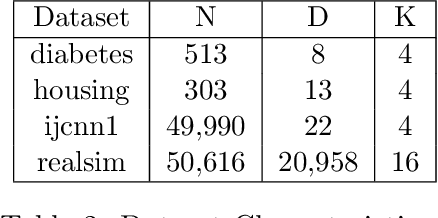
Abstract:Factorization Machines (FM) are powerful class of models that incorporate higher-order interaction among features to add more expressive power to linear models. They have been used successfully in several real-world tasks such as click-prediction, ranking and recommender systems. Despite using a low-rank representation for the pairwise features, the memory overheads of using factorization machines on large-scale real-world datasets can be prohibitively high. For instance on the criteo tera dataset, assuming a modest $128$ dimensional latent representation and $10^{9}$ features, the memory requirement for the model is in the order of $1$ TB. In addition, the data itself occupies $2.1$ TB. Traditional algorithms for FM which work on a single-machine are not equipped to handle this scale and therefore, using a distributed algorithm to parallelize the computation across a cluster is inevitable. In this work, we propose a hybrid-parallel stochastic optimization algorithm DS-FACTO, which partitions both the data as well as parameters of the factorization machine simultaneously. Our solution is fully de-centralized and does not require the use of any parameter servers. We present empirical results to analyze the convergence behavior, predictive power and scalability of DS-FACTO.
Optimization on the Surface of the -Sphere
Sep 13, 2019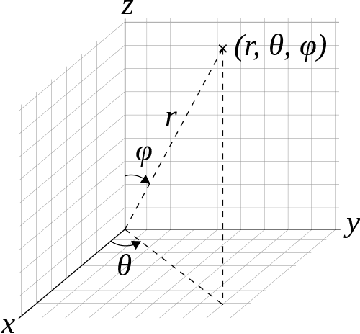

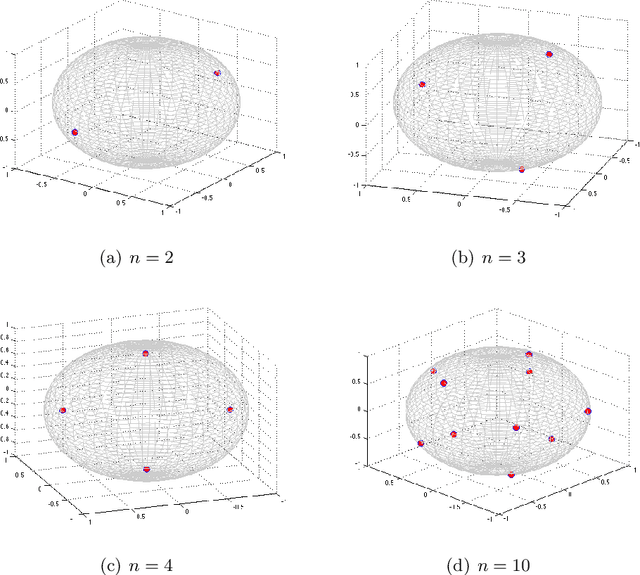

Abstract:Thomson problem is a classical problem in physics to study how $n$ number of charged particles distribute themselves on the surface of a sphere of $k$ dimensions. When $k=2$, i.e. a 2-sphere (a circle), the particles appear at equally spaced points. Such a configuration can be computed analytically. However, for higher dimensions such as $k \ge 3$, i.e. the case of 3-sphere (standard sphere), there is not much that is understood analytically. Finding global minimum of the problem under these settings is particularly tough since the optimization problem becomes increasingly computationally intensive with larger values of $k$ and $n$. In this work, we explore a wide variety of numerical optimization methods to solve the Thomson problem. In our empirical study, we find stochastic gradient based methods (SGD) to be a compelling choice for this problem as it scales well with the number of points.
DS-MLR: Exploiting Double Separability for Scaling up Distributed Multinomial Logistic Regression
Aug 03, 2018



Abstract:Scaling multinomial logistic regression to datasets with very large number of data points and classes is challenging. This is primarily because one needs to compute the log-partition function on every data point. This makes distributing the computation hard. In this paper, we present a distributed stochastic gradient descent based optimization method (DS-MLR) for scaling up multinomial logistic regression problems to massive scale datasets without hitting any storage constraints on the data and model parameters. Our algorithm exploits double-separability, an attractive property that allows us to achieve both data as well as model parallelism simultaneously. In addition, we introduce a non-blocking and asynchronous variant of our algorithm that avoids bulk-synchronization. We demonstrate the versatility of DS-MLR to various scenarios in data and model parallelism, through an extensive empirical study using several real-world datasets. In particular, we demonstrate the scalability of DS-MLR by solving an extreme multi-class classification problem on the Reddit dataset (159 GB data, 358 GB parameters) where, to the best of our knowledge, no other existing methods apply.
Extreme Stochastic Variational Inference: Distributed and Asynchronous
Aug 03, 2018
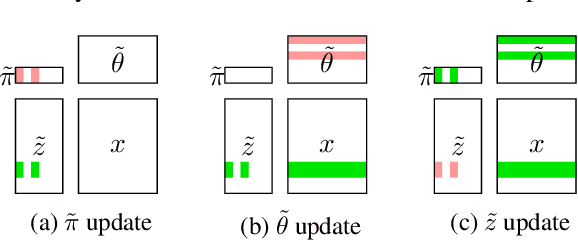
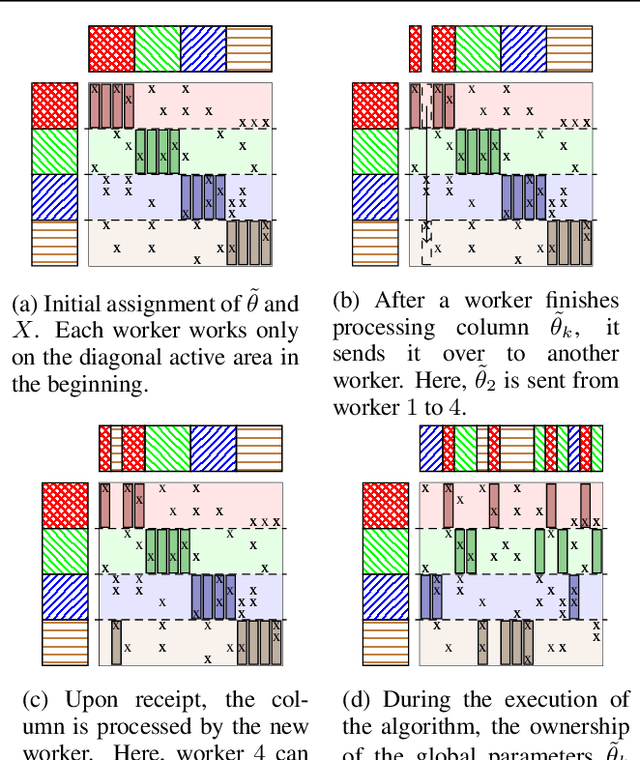
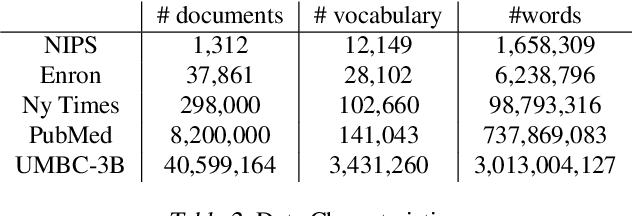
Abstract:Stochastic variational inference (SVI), the state-of-the-art algorithm for scaling variational inference to large-datasets, is inherently serial. Moreover, it requires the parameters to fit in the memory of a single processor; this is problematic when the number of parameters is in billions. In this paper, we propose extreme stochastic variational inference (ESVI), an asynchronous and lock-free algorithm to perform variational inference for mixture models on massive real world datasets. ESVI overcomes the limitations of SVI by requiring that each processor only access a subset of the data and a subset of the parameters, thus providing data and model parallelism simultaneously. We demonstrate the effectiveness of ESVI by running Latent Dirichlet Allocation (LDA) on UMBC-3B, a dataset that has a vocabulary of 3 million and a token size of 3 billion. In our experiments, we found that ESVI not only outperforms VI and SVI in wallclock-time, but also achieves a better quality solution. In addition, we propose a strategy to speed up computation and save memory when fitting large number of topics.
 Add to Chrome
Add to Chrome Add to Firefox
Add to Firefox Add to Edge
Add to Edge